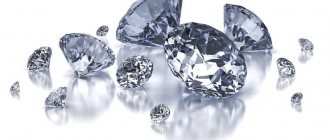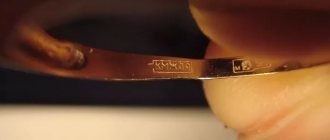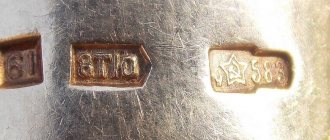Gold is an expensive metal that is used to make fine jewelry in combination with precious stones. Such products have always been valued much more than those in which the main metal is silver. Gold will always be in trend and will never go out of style. Any girl or guy will gladly accept such a gift.
Each of the jewelry differs not only in its design, but in the type of gold that was used. White, yellow or red gold can be used to create a masterpiece. What are their differences?
Story
Gold was used by man many years ago. When wood and stone were taken as a basis, gold was already used for decoration. This is explained by the fact that this precious metal can be easily found in its pure form.
If earlier this metal served only as currency and was used to make various jewelry, then over time it began to be used in various fields. These include electrical engineering, weapons production and medicine.
Many countries store gold bullion in their reserves.
Areas of application
Areas of application:
- Jewelry making.
- Dentistry.
- Chemical, mechanical industry.
- Electronics.
- Food industry.
- Pharmacology.
Gold reserves fuel paper denominations. In the past, precious metal coins were used as money.
Less popular areas of application of the noble metal are energy, nanotechnology, aviation, and the space industry.
Gold coins (Photo: Instagram / mosdragmet)
Chemical and physical properties
Gold is not susceptible to the influence of aggressive environments and substances and does not react. Since the noble metal does not oxidize, it is widely used in many fields.
In its pure form, this material has a rich yellow color and has a soft but dense consistency.
When creating a ball from 1 kg of gold, you will get a sphere with a diameter of 46.2 mm.
Pure gold works well and is easy to forge. But due to softness, impurities from different materials are added.
What is a sample?
Gold is a soft metal, with a Mohs hardness rating of only 2.5. A ring of pure yellow metal can be deformed when squeezed between your fingers with little force. However, gold items are worn daily, passed down from one generation to another, and their appearance is perfect. The secret lies in the additives - ligatures. The practice of adding base impurities to noble metals is aimed at increasing the strength characteristics of the former. Additives may be present in different proportions. The brand determines the presence of a ligature, or, more precisely, how much pure gold is in the material.
There are 4 classifications of markings:
- carat;
- lot;
- spool;
- metric.
In modern life, a metric classification is used to indicate the purity of gold. It is this that is indicated on objects in a series of three numbers.
Types of gold
An alloy of precious metal with a chemical element is used to make jewelry.
The ratio of gold and impurities is the ligature. The reference value is taken as 1000. If 585 is indicated, this means that pure gold contains 585 parts, and 1000-585 = 415 other elements.
Main types
Depending on the composition, different shades of gold are obtained:
- Yellow gold includes gold, silver and copper. This metal has been popular since ancient times to this day. Yellow gold is a symbol of wealth and luxury. This is what most people choose when choosing jewelry. It will always be valuable. The hue and saturation of the yellow color depends on the amount of silver that is in the composition. Color can range from light to dark.
- Red gold. It contains much more copper, which is why it gets this color. In the USSR it was the most popular metal, because there was practically no other gold.
- White gold is often confused with platinum. But such gold differs significantly in price; it is cheaper. Recently it has become popular due to its appearance and cost. The metal gets this color thanks to the elements it contains. These are platinum, nickel and palladium. Nickel is the cheapest of the above, but it is banned in most countries because it can cause an allergic reaction. The quality and price of the product depends on the metal that is included in the composition.
Other types
- Rose gold, which has a delicate hue. This color is formed due to the predominance of copper and Cu-Au-Ag. This shade is rare and popular in the West.
- Green or electrum is an alloy of gold and silver. Previously, cadmium was also added, but it was proven that it negatively affects the human body.
- Purple gold. Less often you can find the name - amethyst. It turns out this color because of the aluminum that is in the composition. Previously, this material was very fragile and was practically not used. Only in 1999, a famous metallurgist from Singapore created the ideal formula that solved this problem.
- Blue gold comes in two types. The first option is a combination with indium, and the second is iron, rhodium, ruthenium and nickel in the composition. In the first case, the result is a rather gray shade, and in the second, a more saturated one.
- Black gold. This color is obtained by applying an oxide layer.
- Gray gold has only recently appeared. This color is achieved by adding steel.
If recently only three types of gold were known, today more than ten are distinguished. These include brown, blue, grey, pink, blue, black, green and purple gold.
Each country prefers its own color of gold. For example, in India and Turkey, gold is bright yellow, while in Russia they prefer the classic yellow color.
Buying gold: opportunities and producing countries
Gold is processed in many jewelry factories and becomes a significant part of state revenue. Each country has its own views on the aesthetic component of gold, as well as its own processing traditions and “recipes” of alloys.
Chinese gold is very pure and almost always yellow gold. Most of the jewelry here is made from metal 750 and higher. It retains the properties of gold - softness, ductility, so the product can quickly deform. But still, buying such jewelry is a contribution to the family budget. Many citizens of the Middle Kingdom store jewelry in special cases and wear it only on very major holidays. The Chinese buy a large amount of jewelry from Russia. White and red gold are less common in China.
Turkish gold is made from imported materials. It is often cheaper than what competitors offer, but there is a catch: very often more impurities are added to gold than indicated, and some of them can even trigger allergies.
Italian gold has earned respect in the market. Italian jewelry houses offer customers white, yellow and rose gold in fancy and stylish combinations. A reddish tint is considered atypical for Italian gold; here it is customary to add more silver than copper.
Arabic gold is a curiosity for our buyer. The percentage of gold content there is usually very high, models with at least 18 carats are welcome. This gold has a rich and bright yellow tint.
Indian gold is also prized for its purity and gold content ranging from 22 karats. This gold is bright, but quite soft, but given the historical values of the Indian people, it is excellent for accumulating family wealth.
Yellow gold
Many people associate wealth with yellow gold. Such jewelry goes perfectly with any stones and suits any look. Shades can range from lemon to dark yellow.
Main advantages
- Availability. You can purchase yellow gold jewelry at any jewelry store.
- Large selection of options. No two pieces of jewelry are identical. Each ring or earrings is different in its appearance.
- The color is unique. Jewelry made from this material retains its shine and tint for a long time if properly cared for.
- Versatility. This metal is suitable for any skin color, age and status in society.
- The price will never fall, and if desired, the jewelry can be easily sold.
White gold
A good alternative to platinum is white gold. This material is popular and has an elegant appearance. Jewelers often combine it with pearls, diamonds or other stones. Such decorations attract attention and admiring glances.
The composition may contain nickel, but it can cause allergies. When purchasing, it is worth studying the components from which the jewelry is made.
Main advantages
- Always in fashion. Such decorations will be relevant even after decades.
- The products are original. They are characterized by an unusual shape and a complex design solution.
- Status. If a person can afford expensive white gold jewelry, then this speaks of his lifestyle and high status.
The influence of different metals in the alloy on the properties of the gold alloy
Silver makes the alloy more ductile and malleable. It also changes the shade of the alloy, making it whiter. If you add more than 30% silver, the shade of the yellow alloy will become noticeably lighter, and when the amount of silver increases to 65%, the gold will turn white. When copper , the alloy becomes harder, but its anti-corrosion properties are reduced. Copper also gives the alloy a reddish tint. Cadmium makes the alloy more easily melted. It also gives the alloy a greenish tint. Zinc gives the alloy properties similar to cadmium. It brightens the alloy, which is why it is used to make white gold. A small amount of zinc can also make the alloy slightly greener. Palladium makes the alloy more refractory, causing the heating temperature to increase. Thanks to this, the alloy becomes noticeably more ductile and lighter - palladium colors it white with a slight beige (flesh) tint. Nickel gives the gold alloy its hardness and changes the color of the alloy to pale yellow. Used as a component of white gold. Platinum bleaches gold more intensely than other alloys and increases its elasticity. Yellowness is lost when the alloy contains about 8% platinum. Nickel, platinum and palladium also give white gold alloys high anti-corrosion properties.
Which one is better?
There is no answer to this question. The color of gold depends on the secondary metals that were used in its creation.
When choosing, you should focus on your preferences and the images with which a person will wear them. Jewelry of 585 standard is suitable for daily wear. 750 standard is less common and more expensive. Such products are worn much less often.
The most expensive gold is white, and the most affordable is yellow. There are lovers of exclusively red gold, but today it is much less common than other types.
What impurities can be added to the alloy?
Impurities that manufacturers and jewelers can add to change the color, properties, and technical characteristics of the metal are copper, silver, platinum, zinc, nickel, manganese, palladium, cadmium, aluminum.
Gold mining
About 100 years ago, people had absolutely no idea how to properly find and mine gold. They trusted their intuition and good vision. Today everything has changed. The deposits of the element are known, and where exactly it is formed.
Over the entire period, more than 160 thousand tons of gold were mined.
Leading countries
For a long time, the Republic of South Africa was considered the leader, but today it is China. Second place is occupied by Australia, and third place by Russia. The USA, Canada, Indonesia, Brazil, Mexico and others also retain their positions.
Known mine deposits
- Muruntau, which is located in Uzbekistan and is the largest deposit. It was discovered in 1958, but mining began for the first time in 1969.
- Goldstrike in the USA. Each year, approximately 124,000 ounces of the precious metal are mined from this deposit. The first production began in 1986.
- Pueblo Viejo (Dominican Republic)
In Russia, gold reserves are estimated at 12.5 tons, but more than half of them are of industrial importance. The most famous mining sites include Sukhoi Log, Berezovskoye and Vorontsovskoye. If there are 2-5 grams of gold per 1 ton of rock, then mining is carried out.
Historical summary
Humanity first learned about gold in the Bronze Age. The main mining sites were located in Ancient Egypt and Mesopotamia. In antiquity, a sacred belief in gold appeared. Many believed that this metal was formed by solar power and could endow a person with it. This metal represented wealth and high status.
Dramatic changes in the world economy occurred in the 18th century. From that period, the development of gold mines began:
- Brazil - 1700.
- California - 1848.
- Australia - 1850.
- Canada - 1896.
How to distinguish gold from fake
Since the cost of gold is quite high, it is very important to be able to identify the craft when purchasing. The best option is to buy products only from trusted stores. You should not trust little-known kiosks and unverified online stores. You can buy a fake there for the price of the original. The price of 1 gram of gold cannot vary significantly in different stores. If it is too small, then there is a high probability that it is a fake.
When purchasing, you need to study the product. There must be a sample on it; if it is difficult to find it, then it is better to use a magnifying glass. But this option does not guarantee authenticity, because a sample is also applied to fakes.
When studying, you should look at all the edges of the material. If it changes color at the joints, then it is a fake.
How to recognize copper in a composition?
Aristotle argued that the best way to determine copper is to taste it. To do this, you need to use two cups made of different materials. They pour the same water into them and drink from them. Water with copper will have a metallic taste, but water with gold will not be at all different from ordinary water.
How to distinguish a fake at home?
To determine the authenticity of gold in a ring, you can throw it on a table (any flat surface) and listen to the sound. If it is crystal clear, then it is original. The disadvantage of this method is that it is not suitable for bracelets, earrings and chains.
- You can try to scratch the product with a sharp knife or a “tooth”. The latter method can often be seen in period films. There will be a mark on the original gold. But there is a high probability of error, because lead also leaves a mark due to its softness.
- Iodine is suitable for testing, which can always be found in the first aid kit. One drop is enough to apply to the decoration. If after 3-5 minutes there is no trace left on the product and no reaction has occurred, then the product is original. There will be a trace on the fake.
- Nitric acid is suitable for identifying the original. If you drop it on gold, no reaction will occur. If the metal is gilded, it will become milky in color. And the fake will turn green. For convenience, this should be done in a metal container.
- When the ring is placed in vinegar, it will not change its color at all. It is often used to purify gold.
- When in contact with a magnet, gold does not react in any way. This method can be safely used when purchasing in a store.
- To check, you can use the decoration of the same sample. You need to take a sheet of paper and run them across it with a little force. The tracks must be identical.
- Color. The shade of gold in the sun and in the shade will help determine authenticity. It should be absolutely the same even in different light. A fake can shine much brighter in the sun than in the shade.
- To determine whether only a product is gold-plated or gold, you should scrape the metal in one place. Gilding may wear off, but gold will not change color.
- If necessary, you can buy a clumsy pencil at the pharmacy. Any material other than gold darkens upon contact with it.
Each of the methods is good, but none of them will accurately answer the question of the authenticity of the jewelry. To be on the safe side, it is better to contact a jewelry maker who specializes in this.
How can I see the sample on products?
To examine the coveted three numbers, you need to arm yourself with a magnifying glass. Even a person with good eyesight can find it difficult to find the marking, since it is deliberately placed in a place hidden from the human eye in order not to spoil the beautiful image of the jewelry. On rings, the mark can be found on the inside side touching the finger. On earrings and chains, the stamp is hidden in a lock. The font is very small and will be difficult to read without a magnifying glass.
How to care for gold?
Gold is a rather fragile material that is susceptible to contamination and requires proper care.
Care Tips
- It is best to remove gold jewelry before doing household chores such as washing and cooking. The same applies to taking a shower and washing your hands.
- Do not throw jewelry, as this can damage it.
- It is best to store products away from sunlight in a soft bag or box. Each ring, bracelet and earrings must have its own packaging.
- Do not use aggressive cleaning agents on gold.
Cleaning jewelry
Proper cleaning of gold jewelry regularly will ensure long-lasting beauty. They will retain their shine and beautiful appearance.
- Dishwashing liquid or soap is suitable for cleaning gold. Just add a couple of drops to a glass of warm water and place the jewelry in it for a couple of minutes. Then wipe with a soft cloth.
- If the jewelry has lost its shine, you should rub it with a soft cloth.
- Dissolve one tablespoon of sugar in a glass of warm water and leave the decoration overnight. In the morning it is washed with warm water. This will make the rings shinier and smoother.
- If necessary, you can contact professionals who will carry out machine cleaning with a special device.
Gold is a precious metal that is distinguished by its beautiful appearance and shine. It will always be relevant throughout the world.











